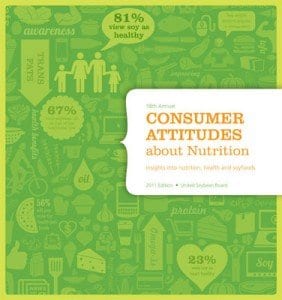 U.S. consumers are more aware today that not all fat is bad. Many realize that there are “good” and “bad” fats, but how many can identify that polyunsaturated and monounsaturated fats belong to the former category?
U.S. consumers are more aware today that not all fat is bad. Many realize that there are “good” and “bad” fats, but how many can identify that polyunsaturated and monounsaturated fats belong to the former category?
The 2011 Consumer Attitudes about Nutrition Survey conducted by the United Soybean Board (USB) gathered opinions of 1,000 U.S. adults on issues of dietary health. The results showed that 53% of the adults in the study agreed that “following a moderate-fat diet but choosing good fats over bad fats” was a healthy eating strategy.
On the other end of the spectrum, 9% of the participants believed that “following a low-fat diet by reducing all fats” was the healthiest eating strategy and that the government recommends this type of diet. The actual diet recommended by authorities places more emphasis on the type of fat consumed instead of the total amount.
Although half the participants thought that eating fat was fine as long as they were healthy, only 33% identified monounsaturated fats as “very healthy” or “somewhat healthy.” In addition, only 33% of the respondents thought that polyunsaturated fat was “very healthy” or “somewhat healthy,” but 79% rated omega-3 fatty acids as being healthy. The disparity highlights an apparent confusion in terminology among the respondents — as fatty acids that contain more than one carbon-carbon double bond, omega-3 fatty acids are classified as polyunsaturated fats.
“Despite an interest in choosing good fats over bad, most U.S. consumers have a hard time pinpointing the healthier choices,” said the USB.
Most participants did agree that trans fats and saturated fats were not as healthy as the other types of fat, with only 9% of respondents believing that trans fats were healthy and 10% believing that saturated fats were healthy.
The USB’s findings are compatible with those of the Food & Health Survey 2011, conducted by the International Food Information Council (IFIC). That survey showed that nearly a fifth of the consumers polled stated that they were attempting to limit both monounsaturated fats (the healthy fats found in nuts, olives, etc.) and polyunsaturated fats (for example, fish oils).
Additionally, The USB’S research revealed confusion among participants over the healthiness of butter and margarine. Over half of the consumers (54%) stated that they believed butter was healthier than margarine or buttery spreads. Yet 24% indicated that they did not know whether butter or margarine was healthier; in 2010, that number was at 14%.
“Results indicate a real need/opportunity for margarine manufacturers to educate via product packaging,” noted the USB. “Consumers who think butter is healthier continue to cite their main reason as ‘it’s more natural’ than margarine. Those who believe margarine is healthier (33%) cite margarine’s lower fat content.”
Consumers were also polled on their attitudes about the relative healthiness of cooking oils. They believed olive oil was the healthiest, then flaxseed oil, canola oil, soybean oil, sunflower oil and safflower oil, according to the USB.
“Consumers continue to perceive soybean oil as a healthy choice. Among consumers with an opinion on healthiness, 81% think soybean oil is very or somewhat healthy.”
More and more consumers are trying soymilk, with 43% of the studies participants having tried it. Edamame has knocked veggie burgers out of the #2 spot in the list of “most consumed soyfoods;” soymilk is the #1 most consumed soyfood.
The USB’s survey also revealed that the consumers ate more soy products at home than they did at restaurants, citing reasons that soyfoods were rarely available in restaurants.